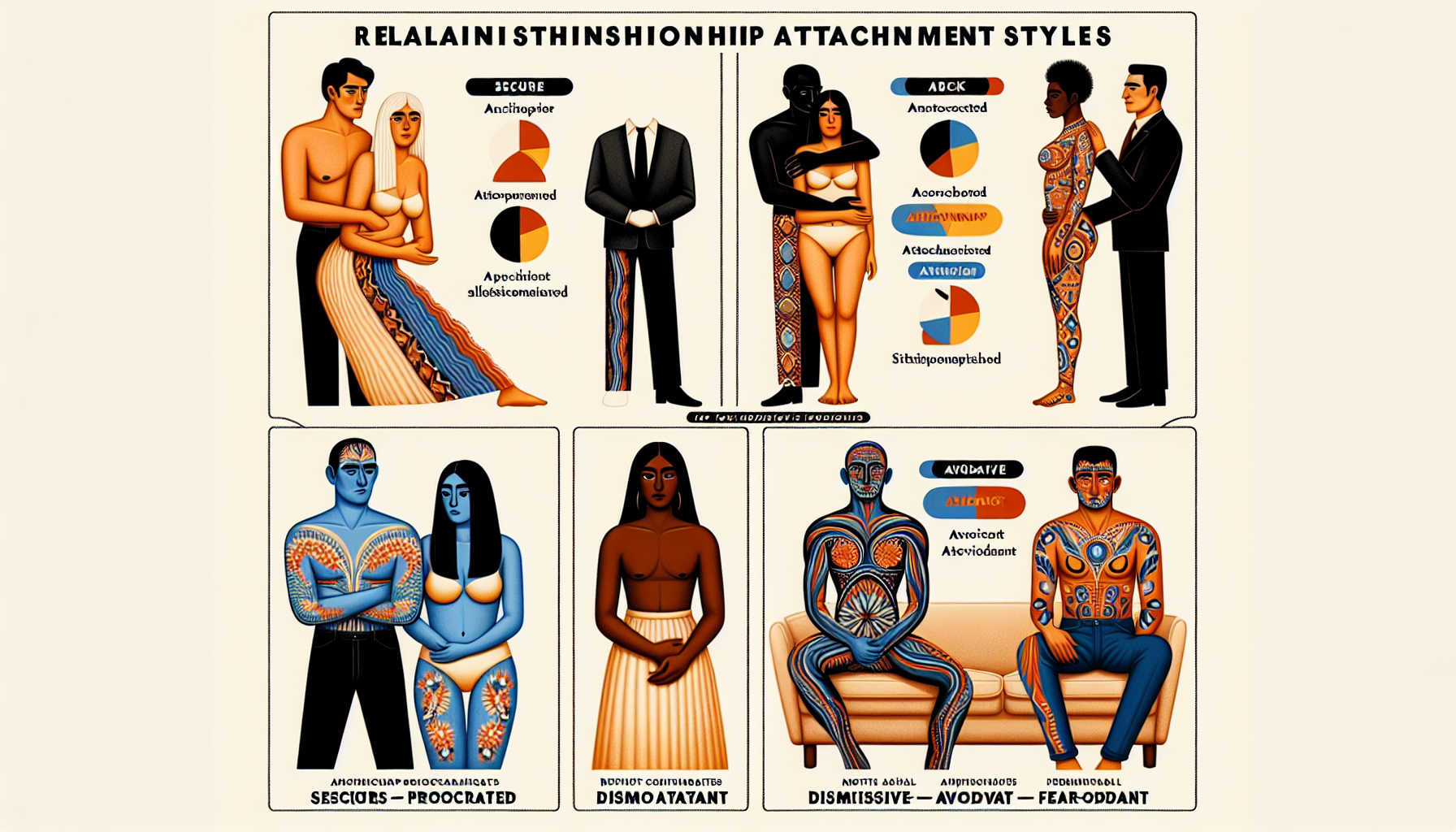
Hey there! Have you ever wondered why some people seem to effortlessly navigate through relationships while others struggle to maintain a healthy connection? Well, the answer might simply lie in their attachment styles. Relationship attachment styles are patterns of behavior and emotional responsiveness that form in early childhood and continue to influence how we approach and interact with our romantic partners. From secure attachments, where individuals feel comfortable with intimacy and independence, to anxious or avoidant attachments, where individuals may fear closeness or become emotionally distant, understanding your own attachment style can be the key to unlocking healthier and happier relationships. So, let’s dive into the fascinating world of relationship attachment styles and discover how they shape our love lives!

Understanding Relationship Attachment Styles
What Are Attachment Styles?
Attachment styles refer to the ways in which individuals form and maintain emotional bonds with others, particularly in close relationships. These styles are developed early in life and are shaped by a combination of genetic, environmental, and personal factors. Attachment styles play a significant role in how individuals perceive and respond to relational experiences, influencing their thoughts, emotions, and behaviors in relationships.
Why Are Attachment Styles Important in Relationships?
Attachment styles are crucial in understanding the dynamics of relationships. They provide insights into how individuals approach intimacy, handle conflict, and navigate emotional connection with their partners. By understanding attachment styles, individuals can gain greater self-awareness and partner understanding, leading to healthier and more fulfilling relationships.
How Attachment Styles Develop
Attachment styles begin to develop in infancy and continue to evolve throughout childhood and adolescence. These early experiences, particularly with primary caregivers, shape the core beliefs and expectations individuals hold about relationships. The four main attachment styles are influenced by the quality of care received during infancy, including consistent caregiver responsiveness and availability.
The Impact of Childhood Experiences on Attachment Styles
Childhood experiences significantly impact attachment styles. Positive experiences with caregivers who are consistently responsive and supportive usually result in the development of a secure attachment style. Conversely, inconsistent or neglectful caregiving may lead to the formation of anxious/preoccupied or avoidant/dismissive attachment styles. Traumatic experiences, such as abuse or loss, can contribute to the fearful/avoidant attachment style.
Types of Relationship Attachment Styles
Secure Attachment Style
Individuals with a secure attachment style feel comfortable with intimacy and autonomy. They have a positive view of themselves and their partners, trusting their ability to provide support and emotional stability. Those with a secure attachment style tend to have healthy and balanced relationships, demonstrating effective communication, emotional availability, and respect for boundaries.
Anxious/Preoccupied Attachment Style
Individuals with an anxious/preoccupied attachment style often experience high levels of anxiety and insecurity in relationships. They seek constant reassurance and validation from their partners, fearing rejection or abandonment. These individuals may exhibit clingy behavior or become overly dependent on their partners, which can strain the relationship.
Avoidant/Dismissive Attachment Style
Individuals with an avoidant/dismissive attachment style tend to prioritize independence and self-reliance in relationships. They may struggle with intimacy and have difficulty trusting others. These individuals often avoid emotional vulnerability and may distance themselves from their partners to protect their independence. This can lead to a lack of emotional connection and dissatisfaction in relationships.
Fearful/Avoidant Attachment Style
Individuals with a fearful/avoidant attachment style often have conflicting emotions regarding intimacy. They desire emotional connection but fear rejection or getting hurt. These individuals may exhibit unpredictable behavior, switching between distancing themselves and seeking closeness. This attachment style can result from traumatic experiences, causing individuals to have difficulty trusting others and forming deep emotional bonds.
Identifying Your Attachment Style
Self-Reflection and Awareness
Self-reflection and introspection are key to identifying your attachment style. Pay attention to your thoughts, feelings, and behaviors in relationships, especially during times of conflict or emotional intensity. Consider your patterns of relating to others and any underlying beliefs or fears that may shape your attachment style.
Common Behaviors and Patterns
Identifying common behaviors and patterns in your relationships can provide valuable insights into your attachment style. Consider whether you tend to seek constant reassurance, avoid emotional intimacy, or exhibit clingy behavior. Reflecting on your reactions to conflict and how you communicate with your partner can also shed light on your attachment style.
Assessments and Questionnaires
Various assessments and questionnaires, such as the Adult Attachment Style Questionnaire (AASQ) or the Experiences in Close Relationships (ECR) questionnaire, can help you assess and identify your attachment style. These tools provide structured inquiries and scoring mechanisms to determine which attachment style(s) may best describe your relational patterns.
Effects of Different Attachment Styles on Relationships
Secure Attachment Style and Relationship Dynamics
Individuals with a secure attachment style typically experience more stable and satisfying relationships. They are comfortable with emotional intimacy and have a positive perception of themselves and their partners. Their ability to effectively communicate, handle conflict, and maintain boundaries contributes to a healthy and balanced relationship.
Challenges and Benefits of Anxious/Preoccupied Attachment Style
Those with an anxious/preoccupied attachment style face challenges in relationships due to their high levels of anxiety and need for constant reassurance. Their fear of rejection or abandonment can lead to clingy behavior and emotional volatility. However, they are often highly attuned to their partner’s emotions and can be deeply caring and loyal.
Avoidant/Dismissive Attachment Style and Intimacy
Individuals with an avoidant/dismissive attachment style may struggle with intimacy and emotional connection. Their strong desire for independence and self-reliance can hinder their ability to fully engage in the relationship. However, they excel at maintaining personal boundaries and may value autonomy, which can contribute to a healthy level of self-care.
Fearful/Avoidant Attachment Style and Emotional Connection
Those with a fearful/avoidant attachment style face challenges in establishing and maintaining emotional connections. Their fear of rejection and past traumas can cause emotional volatility and unpredictable behavior. However, with proper support and understanding, individuals with this attachment style can learn to develop more secure and fulfilling relationships.

Influences on Attachment Styles
Parental/Familial Influence
Attachment styles are strongly influenced by the quality of care received from parents or primary caregivers. Consistent responsiveness, support, and emotional availability from caregivers during infancy and early childhood contribute to the development of secure attachment. Inconsistent caregiving or neglect can lead to the formation of anxious, avoidant, or fearful attachment styles.
Cultural and Societal Factors
Culture and societal norms play a role in shaping attachment styles. Different cultures may prioritize independence or interdependence, affecting individuals’ beliefs and behaviors in relationships. Cultural expectations, societal norms, and gender roles can influence the expression and formation of attachment styles.
Past Relationship Experiences
Previous relationship experiences, including romantic partnerships and friendships, can shape attachment styles. Positive relationship experiences can reinforce secure attachment, while negative experiences such as infidelity or betrayal may contribute to anxious, avoidant, or fearful attachment styles.
Trauma and Abuse
Traumatic experiences, such as physical, emotional, or sexual abuse, significantly impact attachment styles. Individuals who have experienced trauma may develop anxious, avoidant, or fearful attachment styles as a defense mechanism to protect themselves from further harm. These attachment styles can affect future relationships if not addressed and healed.
Changing Attachment Styles
Recognizing the Need for Change
Recognizing the need for change is the first step in shifting attachment styles. If your current attachment style is causing distress or negatively impacting your relationships, it may be time to explore personal growth and healing. Acknowledge any dysfunctional patterns and beliefs that may be holding you back from forming secure and fulfilling relationships.
Seeking Professional Help
Seeking professional help, such as therapy or counseling, can provide support and guidance in changing attachment styles. Working with a qualified therapist allows you to explore your attachment style, address underlying traumas or unresolved issues, and develop healthier patterns and behaviors in relationships. They can provide tools and strategies to help you build secure attachments and navigate relationship challenges.
Exploring Intimacy and Vulnerability
Exploring intimacy and vulnerability is crucial in changing attachment styles. This involves learning to trust others, opening up emotionally, and gradually allowing yourself to become more comfortable with closeness. Engaging in activities that foster emotional connection and practicing effective communication skills can help you build more secure attachments.
Addressing Unresolved Trauma
Addressing and healing unresolved trauma is a critical aspect of changing attachment styles. Traumatic experiences can deeply impact attachment styles, causing fear, mistrust, and avoidance. Working through trauma with a qualified therapist allows you to process and heal from past wounds, enabling you to form healthier and more secure attachments in the future.
Implications for Healthy Relationships
Communication and Understanding
Effective communication and understanding are essential for healthy relationships. Understanding your own attachment style and that of your partner can provide insights into your reactions and behaviors. By recognizing and validating each other’s needs and fears, you can cultivate open and honest communication, leading to a deeper connection.
Creating a Secure and Supportive Environment
Creating a secure and supportive environment is crucial in fostering healthy relationships. This involves providing emotional support, reassurance, and validation to each other. It also means maintaining consistency, trust, and responsiveness, which are vital for individuals with anxious or avoidant attachment styles.
Building Trust and Intimacy
Building trust and intimacy requires time, patience, and effort. Individuals with anxious attachment styles need reassurance and consistency to feel secure. Those with avoidant attachment styles require respect for their need for independence. By prioritizing open communication, mutual respect, and understanding, couples can gradually build trust and emotional intimacy.
Respecting Boundaries
Respecting boundaries is fundamental for maintaining healthy relationships. Each individual has unique needs and comfort levels when it comes to physical and emotional intimacy. Understanding and respecting these boundaries fosters a sense of safety and security, regardless of attachment style.
Tips for Managing Different Attachment Styles
Developing Effective Communication Strategies
Developing effective communication strategies is crucial when dealing with different attachment styles. Encourage open and honest conversations about attachment needs, fears, and triggers. Practice active listening, empathy, and non-judgmental responses to create a safe space for both partners to express themselves.
Encouraging Emotional Availability
Encouraging emotional availability involves creating an environment where partners feel safe to express their emotions without fear of judgment or rejection. This includes actively supporting each other’s emotional well-being, validating feelings, and providing comfort when needed.
Promoting Independence and Autonomy
Promoting independence and autonomy is essential for individuals with avoidant attachment styles. Encourage your partner’s need for personal space and independence, while also maintaining open lines of communication. Balancing togetherness and individuality can contribute to a healthy and sustainable relationship.
Seeking Couples Therapy
Couples therapy can be beneficial in managing different attachment styles. A trained therapist can help facilitate productive conversations, improve communication, and address underlying issues that may be affecting the relationship. Couples therapy provides a supportive and neutral environment for partners to work together towards building a healthier attachment bond.
The Role of Attachment Styles in Breakups and Separation
Attachment Styles and Relationship Dissatisfaction
Attachment styles can significantly impact relationship satisfaction. Anxious individuals may experience dissatisfaction due to their constant need for reassurance and fear of rejection. Avoidant individuals may struggle with emotional connection and intimacy, leading to dissatisfaction. It is crucial to address these attachment styles and work towards building a more secure bond to avoid detrimental effects on the relationship.
Impact on Conflict Resolution
Attachment styles influence how individuals approach conflict resolution. Anxious individuals may fear conflict and be more prone to emotional reactivity, while avoidant individuals may withdraw or shut down during conflicts. These contrasting approaches can exacerbate conflicts and strain the relationship. Developing effective conflict resolution skills, such as active listening and compromise, can help couples navigate disagreements more constructively.
Attachment Styles and Coping with Separation
Attachment styles also affect how individuals cope with separation or breakup. Anxious individuals may experience intense distress and cling to the relationship, desperately seeking reconnection. Avoidant individuals may detach emotionally and try to move on quickly. Understanding these attachment styles can provide insight into the coping mechanisms individuals employ, allowing for more understanding and support during challenging times.
Conclusion
Recognizing the influence of attachment styles in relationships is crucial for building healthy and fulfilling connections. By understanding your own attachment style and that of your partner, you can navigate challenges, foster effective communication, and create a secure and supportive environment. Working towards secure attachment, addressing unresolved trauma, and seeking professional help when needed are key steps towards building and maintaining fulfilling relationships. With effort and dedication, it is possible to cultivate stronger, more secure attachments and experience the joys of healthy, loving partnerships.







